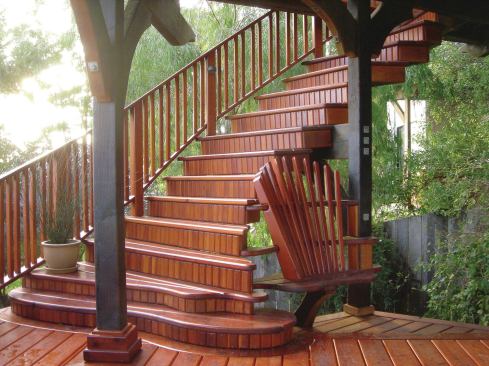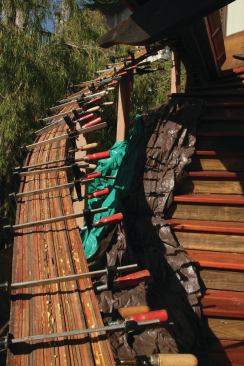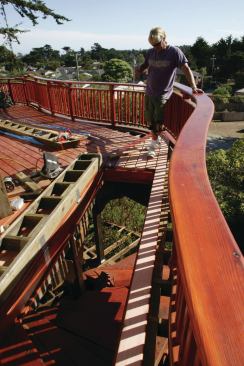Custom Stairs Built by David Bullene
I find that curves in woodwork are more challenging to build and more beautiful to look at than straight lines, which are clean but less compelling. Clients on a recent project shared my passion, which inspired the design of their redwood deck, located in Moss Beach, Calif.
The deck’s centerpiece is a gently curving staircase that opens up through a set of trap doors to a rooftop deck. To build its laminated handrail, I ripped a 20-foot-long select redwood 2×6 into 3/16-inch-wide strips, using a table saw equipped with a Freud Diablo thin-kerf blade. After installing the stair posts, I fastened Bender Board (flexible edging typically used for landscaping) to the posts to act as a form.
Glue-up is a messy and fast-paced process, and takes as many clamps and helpers as you can muster. We coated the strips of redwood with Titebond 3, a waterproof wood glue that has a reasonably long working time, then worked furiously to clamp the glued-up handrail to the Bender Board in order to form the radius. I allowed the glue to cure for about 10 days, then removed the clamps and set the rail on sawhorses, where I cleaned it up and smoothed it out with my various belt sanders.
The deck’s horizontal rails are also curved, but were sawn freehand from 20-foot-long 2×12 redwood stock using a circular saw equipped with an Arcus contoured saw blade and, for the tight turns, from 2×14 stock using a jigsaw. To lay out the handrails, I placed the 2-by stock on top of the framed and trimmed curved deck edge, and traced the profile using the fascia as a guide. Once I completed cutting and smoothing out the 2×6 top rails, I used them as templates for the narrower 2×4 subrails and bottom rails.
The stairs have vertically-oriented risers. As I did with every component in the rest of the deck, I eased their edges with a 3/8-inch-diameter roundover bit mounted in a router, sanded them to 180-grit, then coated them on all sides—especially the end grain—with Sikkens Cetol marine wood finish prior to assembly. Afterward, I filled all the screw holes with wood plugs, touched up any scratches and dings, then brushed on two additional coats of Cetol over the entire deck.
David Bullene is a custom builder (bullenedesigns.com) with over 35 years of woodworking experience who lives in Redwood City, Calif.


